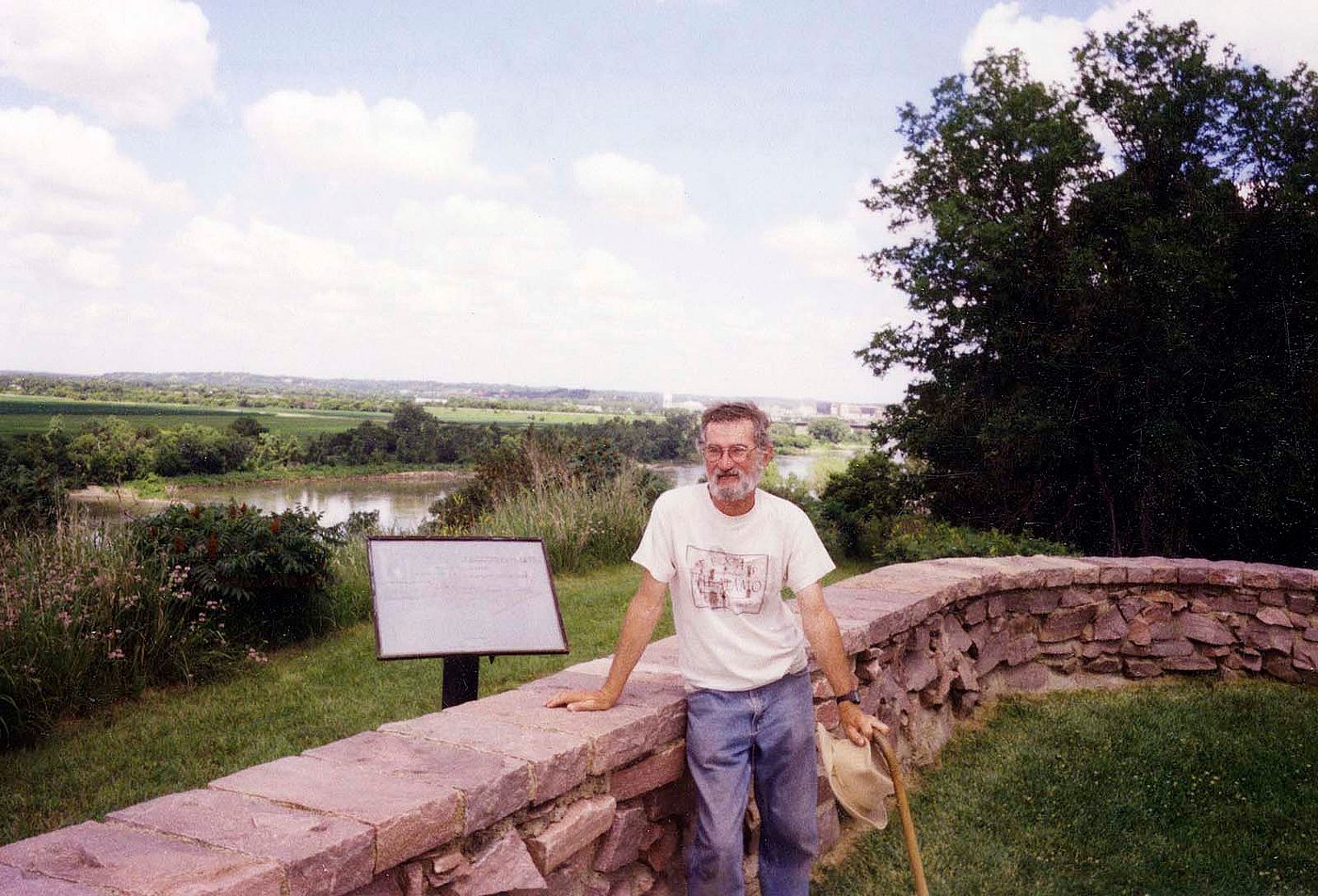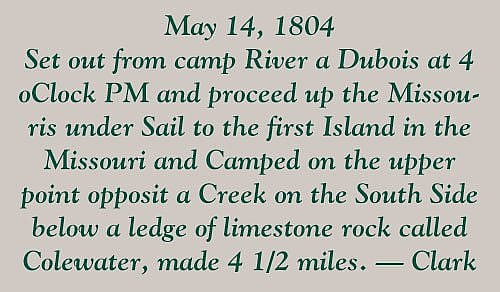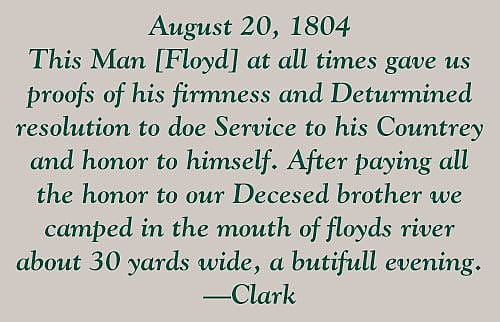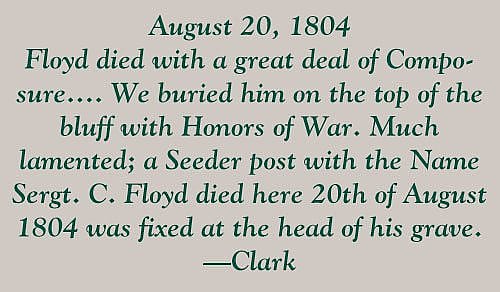
On the Trail with Lewis and Clark, part 1 – Points West Online
Originally published in Points West magazine in Fall 2006
On the Trail with Lewis and Clark, part 1
By Guy Gertsch
Guest Author
In a letter dated June 20, 1803, President Thomas Jefferson wrote Meriwether Lewis: The object of your mission is to explore the Missouri river [sic], & such principal stream of it as by it’s [sic] course and communication with the waters of the Pacific ocean whether the Columbia, Oregon, Colorado or any other river may offer the most direct & practicable water communication across this continent for the purposes of commerce.
Guy Gertsch loves history. He especially likes historical treks—so much so, that he decided to embark on one of the greatest treks of all time: commemorating the Lewis and Clark Corps of Discovery. Captain Meriwether Lewis and Captain William Clark left their “Camp Dubois” near present day Hartford, Illinois on May 14, 1804 and arrived at the mouth of the Columbia River at the Pacific Ocean on November 16, 1805. They wintered there at Fort Clatsop, and then on March 23, 1806, the Corps began its eastern return to St. Louis. Gertsch knows the dates by heart, the geography by sight, and the people by a sort of spiritual connection. This is his story…and theirs.

Pomp was the youngest, only a couple of months old, the next youngest being his mother, Sacajawea, who was 15 or 16 years. The youngest official member of the Corps was George Shannon at 18 years. The average age of the group was in the middle 20s; the oldest members, Sgt. Patrick Gass and Captain William Clark, were at 33 years. Apprised of these statistics, my daughter happily announced my “ineligibility” due to my senior citizen status. Armed with parry—Merriam-Webster’s “evade by an adroit answer”—I explained that if the Corps were around today it would average 232 years of age, and I at a mere 60 years would be the youngest member.
Rationale confirmed, I boarded a plane for St. Louis, so totally excited that I was agitated: I was to become a corpsman in Lewis and Clark’s Corps of Discovery. I had three days to explore prior to launch and made the most of them, first at the Missouri State Historical Society and its Lewis and Clark (L&C) Exposition display. Everything extant from the L&C experience was in evidence: many Thomas Jefferson artifacts, including telescopes, documents, correspondence with Lewis (the real stuff, not copies or prints); Monticello memorabilia; roster signatures; Patrick Gass’ actual diary; writings and diaries of both Lewis and Clark, ad infinitum. So comprehensive was this assemblage of artifacts and explanation of the Corps of Discovery in one place that it encouraged at least a two-day examination.
I spent day three visiting St. Bellefontaine Cemetery [the site of William Clark’s grave] and explained to Captain Clark that I would be seeing him again, soon and often, for the next 4200 miles. My trek would begin tomorrow [May 14, 2004] at 1600 hours, 200 years to the day, minute, and place that the Corps began its own trek from Camp Dubois, Wood River, Illinois, the site of the junction of the Missouri and Mississippi Rivers. I was on the brink of what became the most incredible journey in the world’s history of journeys.
Two centuries later the celebrations had been completed; the re-enactors were poised in their motor driven keelboat and pirogues. And then, amid cannon blasts, band blare, and spectator cheers, the moment of launch was at hand. In the most bizarre of encounters, I met a man named Michael Clark who was planning to follow the phony flotilla across the Mississippi, around the peninsula, and onto the Big Muddy. He had offered me transport so, in manning my own oar, I experienced my first of many admirations for the Corpsmen. Moving a 10-ton keelboat 1,600 miles upriver must have been a bit on the trying side if this two-man canoe was any indication.
![In the most bizarre of encounters, I met a man named Michael Clark who...offered me transport [across the confluence], in manning my own oar, I experienced my first of many admirations for the Corpsmen.](https://centerofthewest.org/cdn-cgi/image/width=800,height=632,fit=crop,quality=80,scq=60,gravity=auto,sharpen=1,metadata=none,format=auto,onerror=redirect/wp-content/uploads/2016/09/PW155_Gertsch-Clark.jpg)
Mike dropped me on the west bank of the Missouri and bid me adieu. I made the first of my many bunks in the bush, and it was delightful. The day had been great—an auspicious harbinger of days to come. I didn’t deceive myself into believing that they would all be so grand, but I was optimistic enough to believe that this incredible beginning was a fine sign.
With my pack on my back and spirits high, I found the following day’s 22-mile hike to St. Charles was not so great. It wound through urban sprawl, but it was well worth the trek to get there. The town was in full L&C promotion, and, with its cobblestone streets and atmospheric restaurants and shops, was really enchanting. The big bonus in being there, however, was that the town marked the head of the Katy Trail, a 180-mile, tree-shaded, strictly pedestrian route that parallels the Missouri River. (The Katy Trail is built on the former corridor of the Missouri-Kansas-Texas [MKT] Railroad—better known as the “Katy.”) With trees on both sides of the trail, the shade came in mighty handy. I do confess some measure of guilt, though, when I looked at the river and visualized the specter of the Corps cordelling that keelboat, as they waded along the bank to pull the boat with ropes, compared to my walking a shaded trail with nothing but a backpack for barrier. Plus, there was always a likely spot to drop a bed at night. This was one of the best segments of the entirety. No motorized vehicles at all, a few joggers and cyclists, an occasional village along the route, and a ton of history.
I visited Daniel Boone’s house near Defiance, Missouri, his grave (one of two) near Marthasville, then on to New Haven across the river, where John Colter spent the last days of his life and is there (somewhere) buried. Next it was on to Herrman, Jefferson City, Columbia—all so pleasant in many ways.

But for the Corps, I was alone, except for the occasional walkers or cyclists I would meet, and those encounters always seemed pleasant. Near Dutzow I chanced upon a couple named Lewis who invited me home with them for dinner and a bunk, which I promptly accepted—the dinner, that is. (With Mr. Lewis here, and Michael Clark who had transported me to the west bank of the Missouri earlier, it struck me that I had met both Lewis and Clark for sure.) Along the trail I found a broken-down cyclist, and after putting the chain back on her cycle she offered me “bunk in her back yard in Defiance,” which I accepted.
A great second in delight were the places. I’d read about many of them, and now I was here. Coming into a tiny place named Franklin, I found a few houses—no people and no amenities, but the name was enough. It didn’t hit me at first, but then the proverbial light bulb turned on: Franklin was the beginning of the Santa Fe Trail where a group of enterprisers, led by William Becknell, had departed in 1821 for the southwest trade, opening one of the great travel routes that joined a growing country.

Once I came upon a town called Arrow Rock, where I was offered a site on a knoll overlooking the river by a man named Ray Widel. He’d seen me walking down the road near Blackwater and stopped to offer me a sandwich and lemonade. I pitched my tent on the knoll above a deerpark, counted the dancing red fireflies until late in the night, and slept well. I liked Arrow Rock so much that I started shopping around for a job.
Then, too, there were descriptions of these locations by the journal entries. And there I was where the Corps had been: the same places, maybe even the same campsites.
Alarm clocks are not necessary on these Missouri treks, especially in May—you simply wake up with the rain. It was tornado season and, at times, the winds were ferocious. I had just passed through Westport, found a not-so-great campsite, bedded down, and had scarcely nodded off when I was hit by what had to have been the fringes of a tornado. The wind wrecked my tent, eventually carrying it away. The rain drenched my gear. I was off the Katy now, so the next day I hobbled out of Missouri and was in Kansas, the nearest place being Atchison, where I took a room in a motel, dried my gear, bought a tent, visited Amelia Earhart’s childhood home and museum, and caught up on railroad history. I visited the Corps campsite on Independence Creek, where they had camped on July 4, 1804. I was moving right along.
Now things were getting serious. Kansas! Not much to look at for a walker. I caught a city bus to get through Kansas City. Then on to Nebraska and more lousy weather. When I came to a town, I generally slept in city parks, but out on the road things were tougher. Several times I bunked in corn fields. One morning I woke up and had momentarily forgotten where I was. But, finding myself surrounded by corn, I swear I heard a voice tell me, “If you build it, he will come.”
I was never without sustenance, however. Every day, these cornhusker families offered lunch or dinner or drink. I was beginning to feel like a character from a Willa Cather novel. I have to tell you, when you’re on the road you meet some real down-home folks. It is quite a revelation to wake up in a city park, find a package next to my pack, and open it to discover a turkey-cheese sandwich, a cold can of soda, a couple of cookies, an apple, and a small container of fruit cocktail. It was the accompanying note that told the story: “Have a nice day!”
I stepped into Iowa for a short piece and visited the Sergeant Floyd graveside monument in Sioux City. Charles Floyd was the only casualty of the Lewis and Clark journey. He died of what is believed to have been appendicitis.
Once in South Dakota, things started to pick up almost immediately. In Vermillion, there is a park right downtown where campers can take a three-day respite from their travels. I did just that, setting up my tent and striking out for Spirit Mound as had some members of the Corps. This is one of the places that the intervening centuries hadn’t changed. Once there, I saw it just as the Corps did and as Clark described it, a place feared by the Native Indians for the legends it inspired. The Mound was six miles from Vermillion. I walked there, climbed it, and knew for a certainty that I was standing in the exact spot where the visiting Corpsmen stood, the vast plains stretching out beneath.

From there I went north and crossed onto the Lower Brule Indian Reservation to yet another of those chance encounters that made the journey so memorable. As I went through the town of Lower Brule, a car pulled over. The driver, a young Indian woman with two children, inquired as to my health. I explained that I was looking for a camping site and she told me to get in. The lady drove me to a quiet camping spot right on the river and left me there. An hour later she returned with a box of chicken, which I accepted, and several bills of money, which I didn’t. Finally, she advised me against further walking travel to Pierre, which was about 50 miles further. As she put it, “There is nothing on that road—not even a gas station—and hardly anybody ever uses it…. And there are no people either.”
Continued in part 2. In the next installment, Gertsch reaches Pierre, South Dakota, then is off to North Dakota as his trek along the Lewis and Clark Trail continues.
Post 155
Written By
Nancy McClure
Nancy now does Grants & Foundations Relations for the Center of the West's Development Department, but was formerly the Content Producer for the Center's Public Relations Department, where her work included writing and updating website content, publicizing events, copy editing, working with images, and producing the e-newsletter Western Wire. Her current job is seeking and applying for funding from government grants and private foundations. In her spare time, Nancy enjoys photography, reading, flower gardening, and playing the flute.















